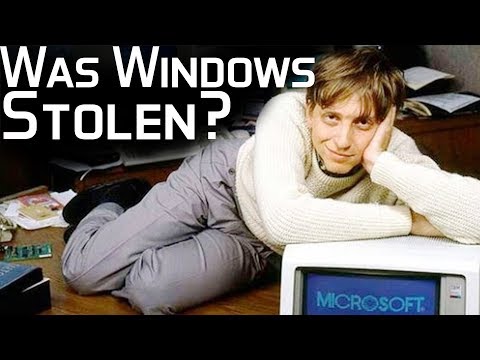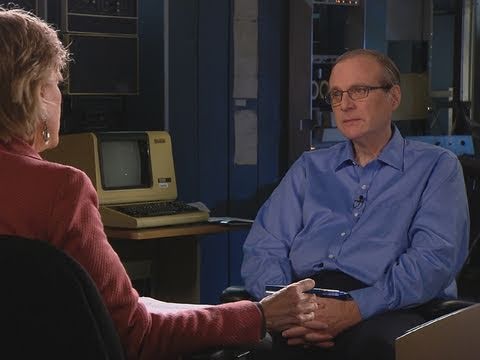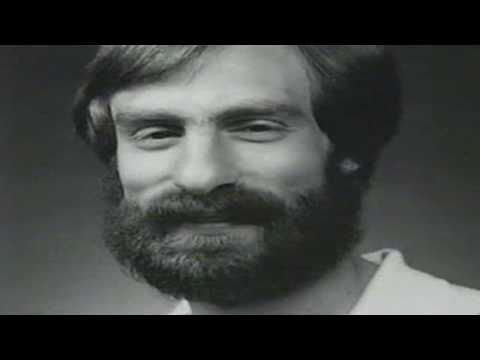L'histoire de Microsoft se confond habituellement avec celle de deux hommes: Bill Gates, et Paul Allen. L'un célébré pour sa philanthropie, et l'autre moins connu du grand public. Paul Allen est le cofondateur de Microsoft. Aujourd'hui décédé, celui-ci publia un livre sur ses années Microsoft.
Suite à cette publication, il fut question dans l'espace médiatique de ses relations plus ou moins conflictuelles avec Bill Gates. Dans une vidéo publiée par CBS News le réalisateur met en avant l'histoire de Allen et revient sur les tensions qui ont marqué sa relation avec Gates.
Pourtant, le succès gigantesque de Microsoft n'aurait pu exister sans un 3ème homme. Gary Kildall. Le véritable génie, c'est lui. A ce titre, cet homme mérite d'être connu et reconnu tant son travail fut visionnaire, novateur, et fondamental à la science informatique.
Nous avons d'autant plus le devoir de le mettre en avant que ses travaux ont été largement plagiés, puis commercialisés à l'échelle planétaire. L'histoire sombre de Kildall se confond avec celle d'un business d'ampleur unique et historique qui non seulement rend ses bénéficiaires immensément riches, mais dont l'apport technologique permet de révolutionner la société pour le meilleur et le pire.
La volonté de faire basculer la société vers un posthumanisme eugéniste a débuté par un vulgaire plagiat. Voici l'histoire de Gary Kildall.
Qui est Gary Kildall?Né le 19 mai 1942 à Seattle, mort à Monterey, il est l'un des grands pionniers de la micro-informatique. Il a créé le système d'exploitation Control Program/Monitor (CP/M) ; paru en 1974 pour les ordinateurs 8 bits, il a plus tard été porté sur des ordinateurs 16 bits (CP/M-86). Plusieurs des autres caractéristiques qui sont parties intégrantes d'un ordinateur personnel aujourd'hui doivent leur origine ou l'une de leurs premières réalisations à Gary Kildall. ( Wikipédia)
Wikipédia confirme sur une autre page (Control Program/Monitor)que « Les premières versions de MS-DOS se sont largement inspirées de CP/M. »
Harold Evans, journaliste, auteur et éditeur réputé, revient sur ce plagiat dans son livre
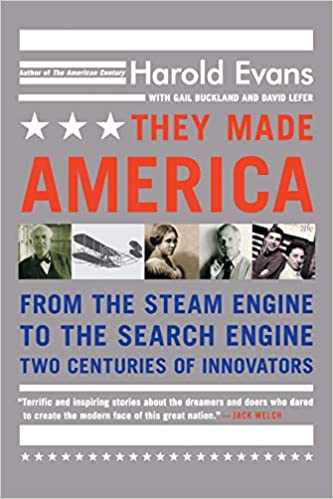
Vidéo où Sir Harlod Evans présente son livre lors d'un dîner organisé par les femmes démocrates aux Etats-Unis: c-span.org Qui est Sir Evans? en.wikipedia.org
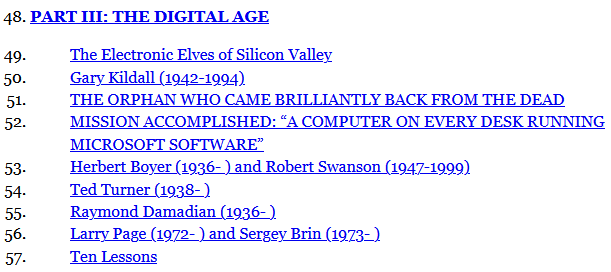
H Evans réserve une bonne place à Gary Kildall dans la partie réservée à l'ère de la digitalisation
Le livre de Sir Evans sera attaqué en justice par Tim Paterson.
« Le programmeur généralement crédité d'avoir construit la base du système d'exploitation informatique de Microsoft a poursuivi un auteur (Sir H Evans) qui prétend que le logiciel n'était qu'une » arnaque « du travail d'un autre homme », rapporte AP.
« Tim Paterson, qui a créé le logiciel plus tard connu sous le nom de DOS et l'a vendu à Microsoft, a déposé lundi un procès en diffamation contre Harold Evans et les éditeurs de son livre They Made America.
« Le procès porte sur un chapitre du livre d'Evans sur Gary Kildall, qui a fondé Digital Research et est décédé en 1994 à l'âge de 52 ans. Le livre affirme que le logiciel de Paterson était simplement un » clone slapdash « et une » arnaque « du CP / M de Kildall. système d'exploitation développé dans les années 1970. «
Source: theguardian.com
Le tribunal va confirmer la place de Gary Kildall en tant que pionnier de l'informatique. En effet, un juge va rejeter l'action en diffamation intentée par Tim Paterson, qui avait vendu un système d'exploitation informatique à Microsoft en 1980, contre le journaliste et auteur Sir Harold Evans et son éditeur Little Brown.
Du coup, l'histoire rapportée par Evans qui décrit comment Paterson aurait copié une grande partie de son interface de système d'exploitation à partir de CP / M devient une réalité historique.
Le Nouveau Monde est une vaste histoire de phagocytage, de plagiat, et de gros sous Nous le savions, mais il est bon de le rappeler et de rendre hommage à ceux qui ont réellement écrit l'histoire.
LHK
Annexes
Hommage à Gary Kildall
Voici un hommage à Kildall sous forme de reportage spécial réalisé par la chaîne sur laquelle il co-présentait une émission.
MS-DOS paternity suit settled
Computer pioneer Kildall vindicated, from beyond the grave
Mon 30 Jul 2007 Andrew Orlowski Bio andrew.orlowskitheregister.com Twitter SHARE ▼

An overlooked court case in Seattle has helped restore the reputation of the late computer pioneer Gary Kildall.
Last week, a Judge dismissed a defamation law suit brought by Tim Paterson, who sold a computer operating system to Microsoft in 1980, against journalist and author Sir Harold Evans and his publisher Little Brown. The software became the basis of Microsoft's MS-DOS monopoly, and the basis of its dominance of the PC industry.
But history has overlooked the contribution of Kildall, who Evans justifiably described as « the true founder of the personal computer revolution and the father of PC software » in a book published three years ago.
In a chapter devoted to Kildall in Evans' They Made America: From the Steam Engine to the Search Engine: Two Centuries of Innovators, Evans related how Paterson « (took) 'a ride on' Kildall's operating system, appropriated the 'look and feel' of (Kildall's) CP/M operating system, and copied much of his operating system interface from CP/M. »
The story of how Bill Gates came to acquire an operating system is well known. In 1980, Kildall's Digital Research provided the operating system for a wide range of microcomputers, and was established as the industry standard. IBM had approached Microsoft, then a tiny software company in the Seattle area, to provide a BASIC run-time for its first micro, the IBM PC. Gates offered to provide IBM an operating system too, even though he didn't have one at the time. This required a hasty purchase.
Microsoft turned to Tim Paterson, whose garage operation Seattle Computer Products was selling a CP/M clone called 86-DOS. This had been developed under the code name QDOS (for « quick and dirty operating system »), and SCP sold it alongside an add-in CPU card. Microsoft turned this into the hugely successful DOS franchise.
(The oft-told story of Kildall spurning IBM to fly his plane is deeply misleading. It was IBM's distribution and pricing of CP/M, which in the end was one of three operating systems offered with the first IBM PC, that ensured MS-DOS captured the market.)
Paterson brought the case against Evans in March 2005, as we reported here, claiming that Evans' defamatory chapter caused him « great pain and mental anguish ».
Evans was puzzled that the chapter drew a defamation suit as it merely « recapitulate(d) and state(d) what 11, 12, 15 other books (said) and there (was) no public outcry, no public corrections, no website corrections, no criticism in reviews (that any of the accounts were erroneous ».
Taking a dim view of lawsuits designed to curb the First Amendment rights of journalists, Judge Thomas Zilly found that Paterson's lawsuit failed on several important counts. In US law, Zilly pointed out, « truth is an absolute defense to a claim of defamation ».
Judge Zilly said Paterson falsely claimed Evans credited Kildall as the « inventor » of DOS, weakening his case. At the same time, the Judge found, Evans had faithfully recorded Paterson's denial of Kildall's view that QDOS « ripped off » CP/M.
The Judge also agreed that Paterson copied CP/M's API, including the first 36 functions and the parameter passing mechanism, although Paterson renamed several of these. Kildall's « Read Sequential » function became « Sequential Read », for example, while « Read Random » became « Random Read ».
(DR came to regret not suing Microsoft « very early on ». For his part, Paterson was to plead that his operating system of choice, Kildall's CP/M-86, was at the time unavailable for products based on Intel's 8086 that he wanted to sell, necessitating the hasty clone).
Finally, Judge Zilly concluded that Evans acted without malice, and castigated the plaintiffs for introducing irrelevancies into court, including the claim that Kildall was an alcoholic.
« Plaintiffs fail to provide any evidence regarding 'serious doubts' about the accuracy of the Kildall chapter. Instead, a careful review of the Lefer notes provides a research picture tellingly close to the substance of the final chapter. »
And with that, the case was dismissed.
The PC world might have looked very different today had Kildall's Digital Research prevailed as the operating system of choice for personal computers. DRI offered manufacturers the same low-cost licensing model which Bill Gates is today credited with inventing by sloppy journalists - only with far superior technology. DRI's roadmap showed a smooth migration to reliable multi-tasking, and in GEM, a portable graphical environment which would undoubtedly have brought the GUI to the low-cost PC desktop years before Microsoft's Windows finally emerged as a standard.
But then Kildall was motivated by technical excellence, not by the need to dominate his fellow man. ®
Source theregister.com
Sponsored: Practical tips for Office 365 tenant-to-tenant migration
Version française de l'histoire de Kildall
